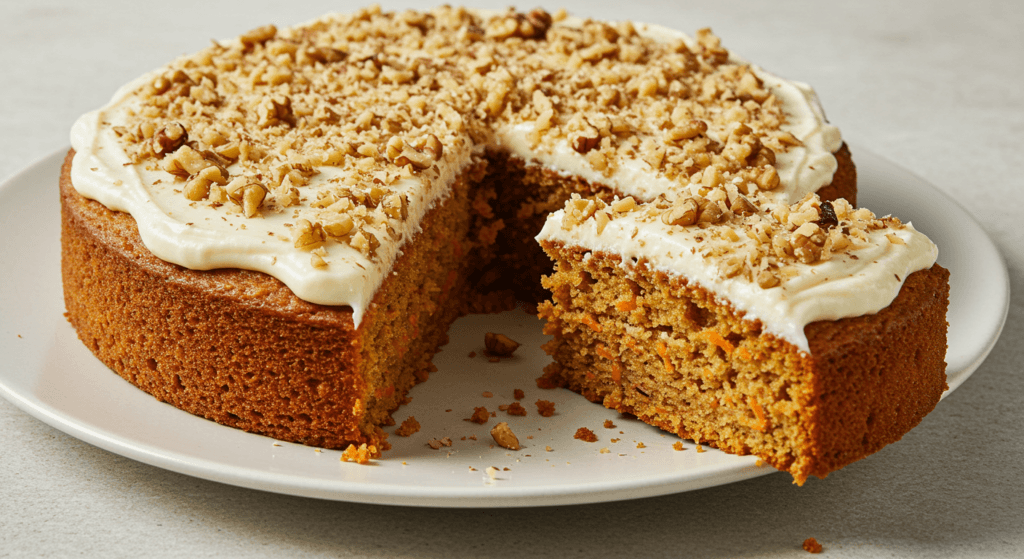
Table of Contents
Carrot walnut cake stands as one of the most beloved desserts worldwide, combining the natural sweetness of carrots with the rich, nutty flavor of walnuts to create a moist, flavorful treat that satisfies both casual snackers and dedicated dessert enthusiasts. This comprehensive guide explores everything you need to know about creating the perfect carrot walnut cake, from its fascinating history to expert baking tips and nutritional benefits.
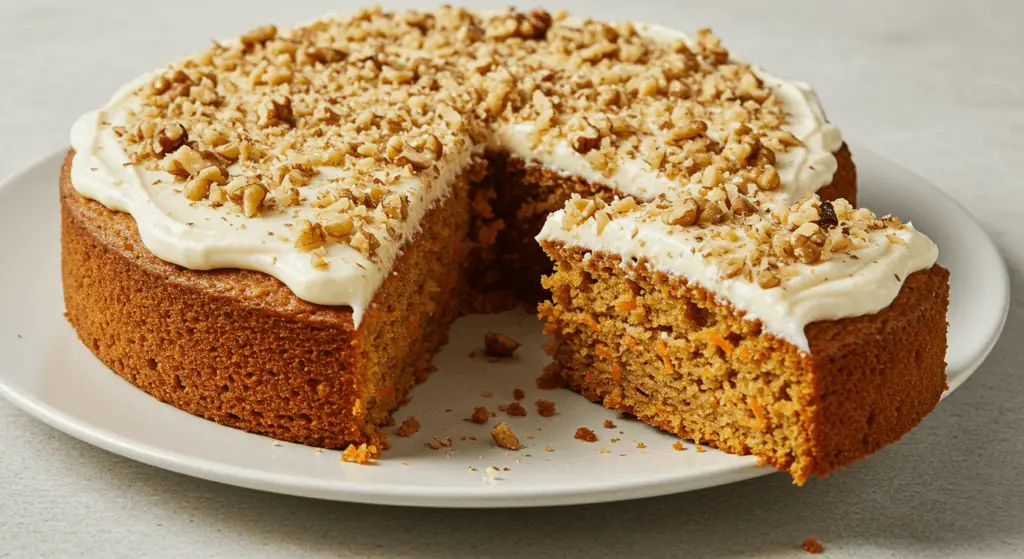
What Makes Carrot Walnut Cake Special?
What sets carrot walnut cake apart from other desserts is its remarkable moisture content and complex flavor profile. The grated carrots release moisture during baking, ensuring the cake remains tender for days after baking. Meanwhile, the inclusion of walnuts provides a satisfying textural contrast and nutritional boost. When topped with classic cream cheese frosting, the cake achieves perfect balance between sweet, tangy, and nutty flavors.
The History of Carrot Cake
Carrot cake’s origins trace back to medieval Europe, where carrots were used as a sugar substitute due to their natural sweetness during times when sugar was expensive and difficult to obtain. The modern version of carrot cake as we know it today gained popularity in the United States during the 1960s and 1970s, coinciding with a growing interest in health foods and natural ingredients.
The addition of cream cheese frosting—now considered an essential component—became standard during this period, transforming what was once viewed as a health food into an indulgent dessert. The inclusion of walnuts further enhanced the cake’s texture and flavor, creating the classic carrot walnut cake recipe enjoyed worldwide today.
Essential Ingredients for Perfect Carrot Walnut Cake
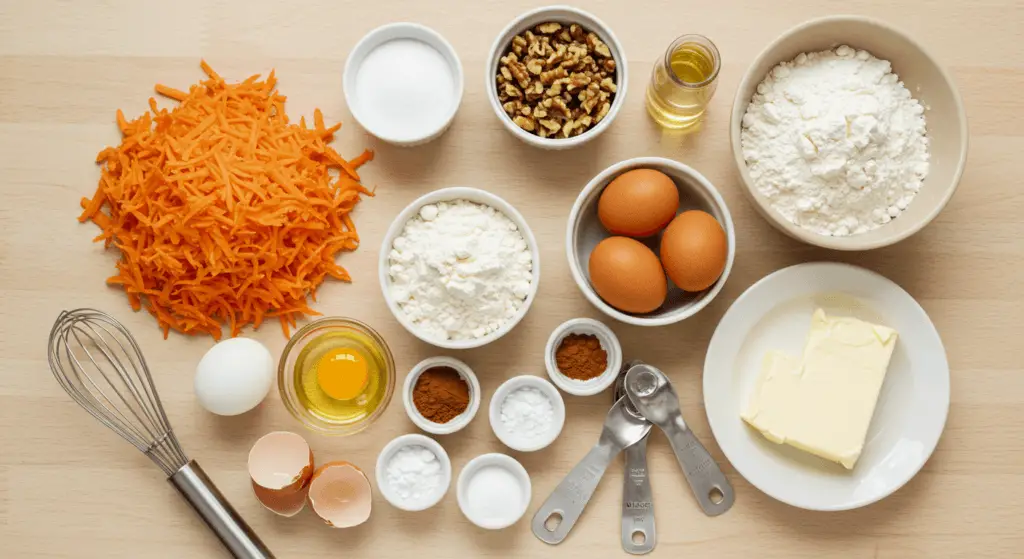
The Core Ingredients
- Carrots: 1 cup of freshly grated carrots provides moisture, natural sweetness, and that distinctive orange fleck throughout the cake.
- Walnuts: 1/2 cup of chopped walnuts adds texture, nutrition, and a rich, earthy flavor.
- Eggs: 4 large eggs serve as the binding agent, creating structure while contributing to moisture.
- Sugar: 1.5 cups (225g) of granulated sugar balances the flavors and contributes to the cake’s tender texture.
- Oil: 1 cup (200ml) of vegetable oil ensures the cake stays moist for days after baking.
- Milk: 1 cup (200ml) adds richness and helps activate the leavening agents.
- Flour: 2.5 cups (300g) of all-purpose flour provides structure to the cake.
- Spices: 1 teaspoon of cinnamon enhances the warm, comforting flavor profile.
- Leavening agents: 1 teaspoon of baking powder and 1/2 teaspoon of baking soda ensure proper rise.
For the Classic Cream Cheese Frosting
- 8 oz (225g) cream cheese, softened
- 1/4 cup (55g) unsalted butter, softened
- 2 cups (240g) powdered sugar
- 1 teaspoon vanilla extract
- Additional chopped walnuts for garnish
Step-by-Step Preparation Guide
Preparing the Batter
- Preheat your oven to 350°F (175°C) and grease a 9-inch cake pan or line with parchment paper.
- Combine dry ingredients in a medium bowl: flour, cinnamon, baking powder, and baking soda. Whisk together and set aside.
- Beat the eggs and sugar in a large bowl until light and fluffy, about 3-4 minutes using an electric mixer.
- Add oil and milk gradually while continuing to mix at medium speed.
- Incorporate dry ingredients into the wet mixture, mixing just until combined. Overmixing can lead to a dense cake.
- Fold in grated carrots and chopped walnuts gently with a spatula until evenly distributed.
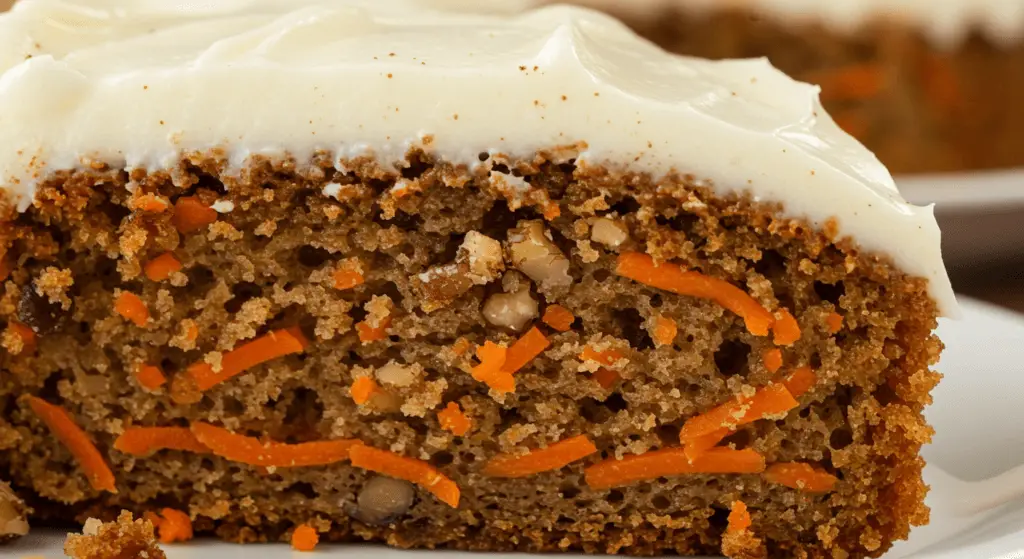
Baking to Perfection
- Pour the batter into the prepared cake pan, smoothing the top with a spatula.
- Bake for 35-40 minutes, or until a toothpick inserted into the center comes out clean or with a few moist crumbs.
- Cool completely before frosting. Place the cake on a wire rack and allow it to cool in the pan for 10 minutes, then remove from pan and cool completely.
Creating the Cream Cheese Frosting
- Beat cream cheese and butter together until smooth and creamy.
- Add powdered sugar gradually, mixing at low speed initially to avoid a sugar cloud.
- Mix in vanilla extract and beat until light and fluffy.
- Spread the frosting over the cooled cake with an offset spatula.
- Garnish with chopped walnuts, pressing gently to adhere to the frosting.
Expert Tips for Baking Success
- Don’t overmix the batter once you add the flour. Mix just until ingredients are incorporated to ensure a tender crumb.
- Fresh carrots are essential. Avoid pre-shredded carrots from the store as they tend to be dry and lack flavor. Grate your carrots just before mixing into the batter.
- Toast your walnuts before adding them to the batter to enhance their flavor. Spread them on a baking sheet and toast at 350°F (175°C) for 8-10 minutes.
- Room temperature ingredients lead to better incorporation, especially for the cream cheese frosting.
- Allow the cake to cool completely before applying frosting to prevent it from melting.
Nutritional Benefits
While carrot walnut cake is certainly an indulgence, it does offer some nutritional advantages over other desserts:
- Carrots provide beta-carotene, vitamin K, potassium, and antioxidants.
- Walnuts offer omega-3 fatty acids, protein, and antioxidants.
- The oil-based recipe (rather than butter) often contains less saturated fat.
- The natural moisture from carrots means less fat is needed for a moist texture.
Variations to Try
- Spiced Carrot Cake: Add 1/2 teaspoon each of nutmeg, ginger, and allspice for a more complex flavor profile.
- Tropical Twist: Include 1/2 cup of crushed pineapple (well-drained) and 1/2 cup of shredded coconut.
- Mixed Nut Version: Substitute half the walnuts with pecans for varied texture and flavor.
- Healthier Option: Replace half the oil with unsweetened applesauce and reduce sugar by 1/4 cup.
- Gluten-Free Alternative: Substitute regular flour with a high-quality gluten-free flour blend with xanthan gum.
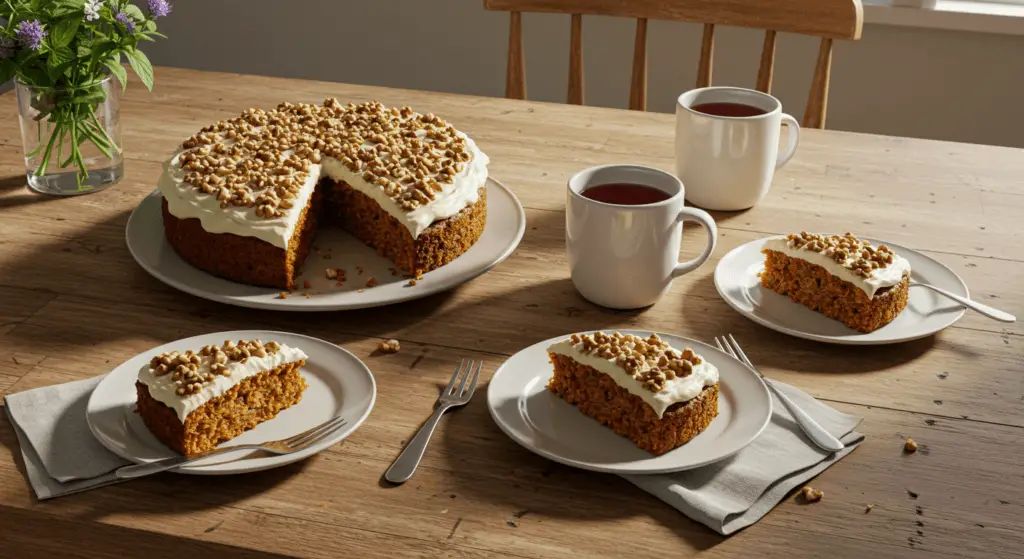
Storage and Serving Recommendations
- Counter Storage: The cake will stay fresh at room temperature for up to 2 days if covered.
- Refrigeration: Store in an airtight container in the refrigerator for up to 5 days.
- Freezing: Wrap unfrosted cake layers tightly in plastic wrap and aluminum foil; freeze for up to 3 months.
- Serving Temperature: For the best flavor and texture, bring refrigerated cake to room temperature before serving.
 DINNER
DINNER  LUNCH
LUNCH 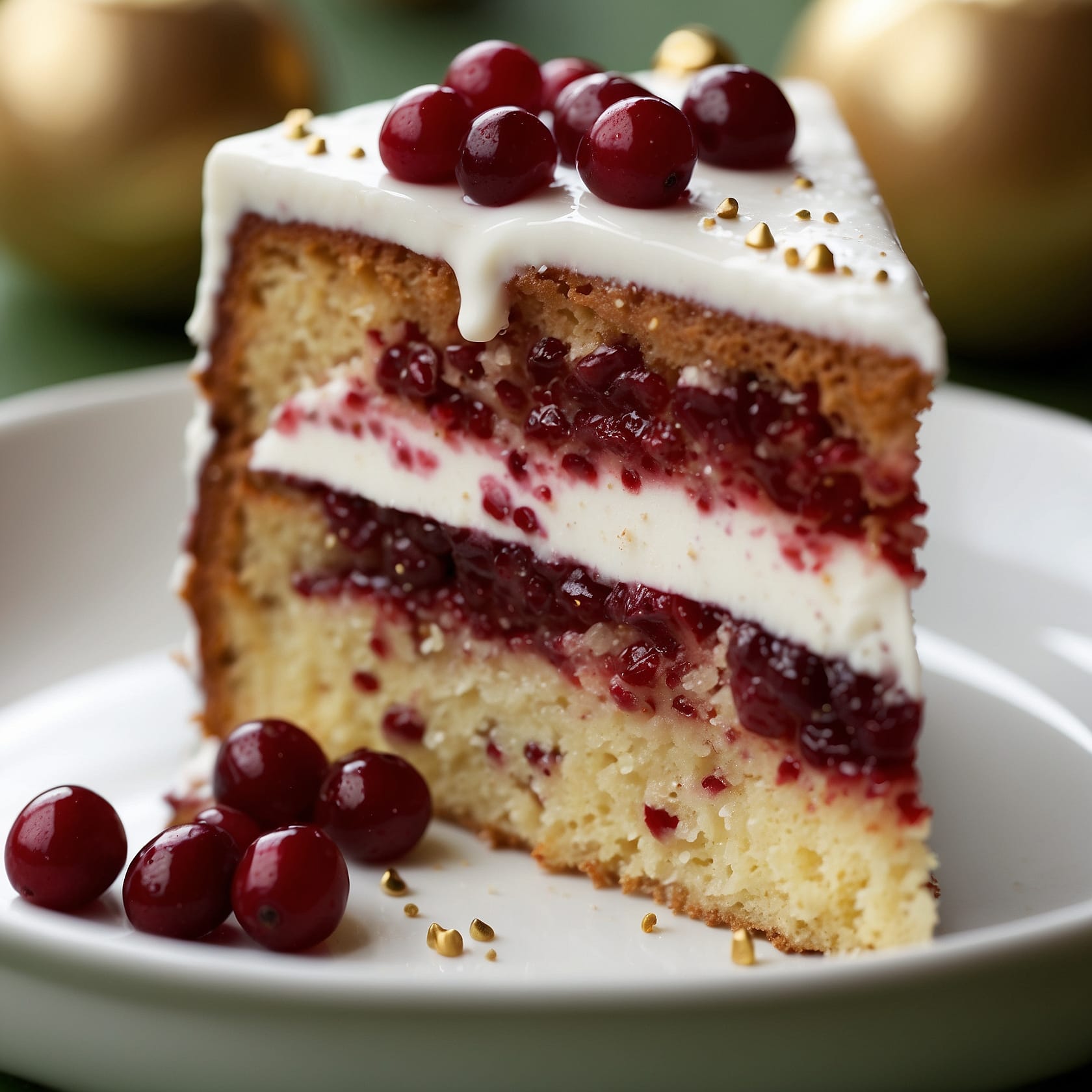 CAKE
CAKE  BREAKFAST
BREAKFAST For more amazing recipes, be sure to check out our other sections to explore a variety of ideas that will enrich your cooking experience. Each section offers its own unique flavors to ensure a delightful culinary journey:
- Easy and Quick Recipes: A collection of dishes that guarantee delicious meals with minimal effort and time.
- Healthy Recipes: Discover healthy and delicious options that fit your lifestyle.
- Desserts: A diverse selection of sweets that will add a special touch of sweetness to your table.
- Lunch Recipes: Tasty lunch ideas that you can easily prepare to delight your family.
- Dinner Recipes: Delicious and easy-to-make recipes that will make your dinner a memorable occasion.
Frequently Asked Questions
Why did my carrot cake turn out dry?
Dry carrot cake typically results from overbaking or measuring flour incorrectly. Use the spoon-and-level method for measuring flour rather than scooping, and check your cake early with a toothpick test.
Can I make this cake ahead of time?
Absolutely! Carrot cake actually improves in flavor after a day as the spices meld. You can bake the cake 1-2 days ahead, wrap it well, and frost it before serving.
How finely should I grate the carrots?
Medium-fine grating works best. Avoid using the finest grater setting as this can cause the carrots to disappear into the batter, losing texture. A standard box grater’s medium holes produce ideal results.
Can I substitute walnuts with other nuts?
Yes, pecans make an excellent substitute for walnuts. Almonds can work as well, though they provide a different flavor profile.
Is there a dairy-free alternative for the frosting?
You can use dairy-free cream cheese alternatives and plant-based butter substitutes for the frosting. Several brands now offer products that perform similarly to traditional cream cheese.
Conclusion
Carrot walnut cake represents the perfect balance between indulgent dessert and wholesome ingredients. Its enduring popularity stems from its incredible moisture, complex flavors, and the comforting warmth of its spices. Whether you’re baking for a special occasion or simply craving a delicious treat, this classic dessert never disappoints.
By following the techniques and tips outlined in this guide, you’ll create a carrot walnut cake that’s moist, flavorful, and guaranteed to impress anyone fortunate enough to enjoy a slice. The combination of freshly grated carrots, toasted walnuts, warm cinnamon, and tangy cream cheese frosting creates a truly memorable dessert experience that has stood the test of time.
So heat up your oven, gather your ingredients, and prepare to bake a carrot walnut cake that will quickly become a favorite in your recipe collection. Your taste buds—and anyone you share it with—will thank you.
